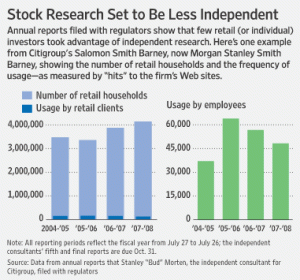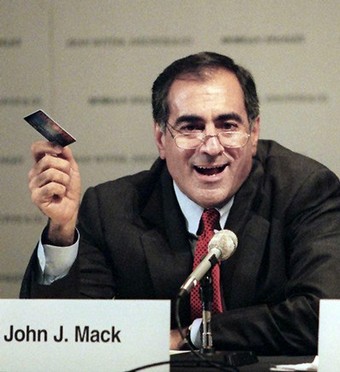Very interesting article yesterday at the Wall Street Journal. Entitled, “Stock-Research Reform to Die“, the article describes what’s happened in the wake of Eliot Spitzer’s landmark settlement against Wall Street brokers in 2003.
 According to the WSJ, this settlement was part of a wider Wall Street wrist-slap against ingrained culture that issued “overly optimistic stock research in order to win investment banking business.”
According to the WSJ, this settlement was part of a wider Wall Street wrist-slap against ingrained culture that issued “overly optimistic stock research in order to win investment banking business.”
One of the results of the settlement required major brokerage houses to spend $460+ million on independent stock research for their clients.
The WSJ’s conclusion: six years later and almost no clients are using independent research.
At Credit Suisse, which has mostly institutional clients, the number of times retail clients accessed independent research from the firm’s Web site ranged from 16 during the third year of the settlement to 110 the first year.
At the old Salomon Smith Barney — now part of Morgan Stanley’s Morgan Stanley Smith Barney — its roughly 4 million retail households accessed about 12,000 reports each month. Less than 2% of Goldman Sachs Group Inc.’s Private Wealth Management clients likely downloaded a report each month, according to data from the public reports.
The WSJ mentions 3 reasons why investors haven’t taken up independent research at their broker:
- investors rely upon their brokers to act as a screen: While 11% of brokers consumed independent research at least occasionally, they typically don’t send independent research out to clients.
- investors don’t rely as heavily on stock research today as they used to: “In the late 1990s, a positive report from a hot analyst could send a stock soaring. That effect is more muted today.”
- structural changes away from brokers to advisors: Commission-based business is old-school. It’s been replaced by fee-based professionals acting as advisors. There is less emphasis on trading at the retail level and less need for this type of research. Combined with chinese walls going up between brokerage and investment banking, banks are cutting back on research teams as research becomes harder to monetize without the tie-in with banking.
Just wanted to chime in with a couple of comments:
- I agree that full-service brokerage clients rely upon their brokers to act as screens. That’s why they pay them and why they work with an advisor. The vast majority of clients do not know how to read research or want to be bothered. They want a quick synopsis why they should own a particular stock and for that, the broker acts as a type of well-heeled Cliffs Notes.
- Maybe investors weren’t even aware that independent research was an option? Do they know why it’s important? Are investors aware of the biases which still exist in sell-side research?
- Why depend on the guilt party to distribute the cure to the sickness? That’s nuts.
- Totally disagree with the fact that investors don’t rely on research. I would say that it’s more accurate to say that given historical conflicts of interests, investors no longer trust institutional research. Given the gaping void left by Wall Street and the rise of financial bloggers and aggregation sites like SeekingAlpha, many investors are actually consuming more research on more companies than ever. We’re in a Renaissance/Gold Run/Bull Market for investment content — it’s institutional research that’s not finding its footing.
- It’s hard for brokers today. Without an edge in research or asymmetrical information, it’s hard to push stocks and get paid for it. That’s why many brokers have become mere wolves-in-sheeps-clothing: they’re still brokers but get paid as advisors. We’re also seeing the emergence of true financial fiduciaries who work extremely hard for their fees and performance for clients, in up and down markets. These advisors are doing real research or hiring people who do and they’re the ones consuming the research, not clients.
- I think we’re seeing the investment field changing so quickly before our eyes. On one hand, we’re seeing investors go boutique and sign up with independent financial advisors. This is like more full-service than full-service. On the other hand, we’re seeing investors retake the reins of their portfolios and managing things on their own — classic DIY investing online. There is also a middle ground of investors who want more control but also want professional advice to support them along the way. Regardless of the model, someone is consuming research, whether it’s the client or the advisor.
- We need new business models to foster more independent research to fill the gap left by Wall St.’s void. Tools to rate accuracy and trust-worthiness. Performance. From individual positions in a portfolio to the dynamics of portfolio management in general.
Interesting to see that most of the firms polled in the WSJ article were not planning on continuing distributing independent research. Some have jettisoned research while others are bolstering their efforts. That still leaves a tremendous opportunity out there for anyone who can provide actionable advice to the majority of investors out there.
Additional Resources
- Subscribe to receive free daily updates from NewRulesofInvesting.
- Follow me on Twitter
- WSJ’s Stock-Research Reform to Die
- SEC: landmark settlement against Wall Street brokers in 2003
- E*Trade further blurring the lines between full-service brokerage and DIY investing
- How investing is changing before our eyes



 freezing Lehman’s account, it looks like Lehman may have entered a death spiral. The point here is that given our various integrated relationships, it’s important to look at everything, from accountant to lawyer to bank to hosted CRM platform and test how dependent we are on our partners.
freezing Lehman’s account, it looks like Lehman may have entered a death spiral. The point here is that given our various integrated relationships, it’s important to look at everything, from accountant to lawyer to bank to hosted CRM platform and test how dependent we are on our partners. adviser throughout this process. Customers understand that there are issues beyond the control of the service provider. What they really demand, though, is the guidance of the service provider during tough times.
adviser throughout this process. Customers understand that there are issues beyond the control of the service provider. What they really demand, though, is the guidance of the service provider during tough times.